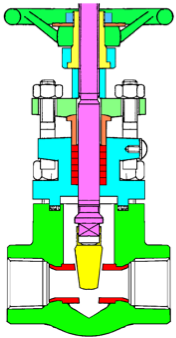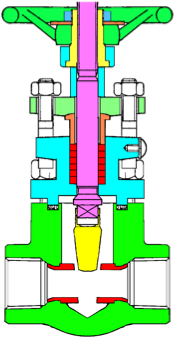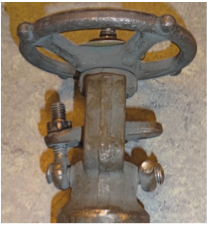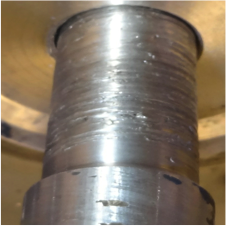The great globe valve / gate valve misunderstanding
The great globe valve / gate valve misunderstanding
Normally when testing a new pipe system, the pipe and valves undergo initial testing that consists of two leak tests, a 150% hydrostatic test and an N2He leak test. These tests not only test the flanges connecting the valve to the pipe, but also test the bonnet body connection and all the plugs/fittings in the valve body. To ensure that the cavity of a parallel-gate or ball valve is fully pressurized during the test, the valves are left in a 50% open position as illustrated in fig. 1. So far so good.
But what about the most commonly used valves, the globe and wedge-gate valves? If these valves are left in 50% open position as illustrated in fig. 2, the pressure from the cavity will now be in contact with the spindle packings, which are usually made of graphite. When tested with 150% of design pressure and with small molecules such as Helium, it is common to tighten the press-gland bolt to secure a good test result.
The problem with this is the danger of over-tightening the packings and increasing the force needed to operate the valves. When the friction increases, the operational wear and tear of the packings also increases. There is also a danger of tilting the spindle when tightening the press gland without the valve being in back-seat position. This tilting may make the spindle rub against the bonnet during operation, creating a danger of scratching the spindle due to galling.
If the spindle packings start to leak due to mistreatment during the initial testing, it is not unusual that the press gland is tightened still further, and this can lead to serious damage to the press gland and/or gland bolts. Fig. 4 illustrates how the press gland has been bent due to the excessive force applied to the gland nuts/bolts. If too much force is used on the press gland, it may lead to a stretched and torn gland bolt as pictured in fig. 5.
The best way of avoiding this problem is illustrated in fig. 3. When performing the initial testing, operate the globe and gate valves in fully-open position so that the valve is in the back-seat position. Then loosen the press-gland nut and let the spindle packings be uncompressed and relaxed. Now the initial test will be able to disclose a bad spindle and/or bonnet seat. If the back seat is performing poorly, it may be necessary to change the valve. After all, the back seat is supposed to be a tested metal-to-metal seal.
When the initial tests are completed, the spindle packings can be tightened to the correct level of compression so the packings seals do NOT constitute an excessive force on the spindle. In this way, excessive wear is avoided, and we maintain the life expectancy of the packings.
There are two things to remember:
1. Compressed graphite packings will not be decompressed if loosened, they will leak.
2. Always keep the spindle in back-seat position when tightening the spindle packings, otherwise the graphite packings may be compressed unevenly and lead to a tilted spindle resulting in galling on the spindle and major leaking through the spindle packings as pictured in fig. 6; that valve had to be replaced.
Do you want to download this article as a PDF?
Click here to download






